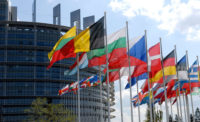 An international federation of trade unions representing the people who prepare and manufacture food is issuing a warning about the increasing use of nanomaterials by food manufacturers.
An international federation of trade unions representing the people who prepare and manufacture food is issuing a warning about the increasing use of nanomaterials by food manufacturers.
‘Products containing engineered nanoparticles are being rapidly introduced into commercial production at every stage of the food chain, yet there are no specific safety regimes or adequate hazard assessments in place to protect workers, the public and the environment,’ said Ron Oswald, General Secretary of the IUF.
An example: nanoparticles of titanium dioxide are now found in products like peanuts and chewing gum.
Recommendations
The IUF has issued recommendations calling on companies to:
- adopt a detailed public policy explaining their use of nanomaterials
- publish a safety analysis for any nanomaterials being used
- issue supplier standards label all products that contain nanoparticles smaller than 500nm and
- adopt a hierarchy of hazard controls approach to prevent exposure of its employees to nanomaterials
A growing number of studies have indicated that a range of health harms may be caused by ingestion or inhalation of engineered nanomaterials, which are materials containing extremely small particles (a human hair is 100,000 nanometers wide).
What the FDA says
The United States Food and Drug Administration (FDA) , which has not yet issued nanomaterials regulations for food additives, states in its guidance that they "are not aware of any food ingredient...on the nanometer scale for which there are generally available data sufficient" to determine that the ingredient is Generally Recognized As Safe.'
To date, no government regulatory agency has introduced appropriate nano-specific workplace, consumer or environmental requirements. The European Trade Union Institute (ETUI) blames corporate lobbyists, who they say “have successfully resisted regulation and even the establishment of publicly accessible registers of products containing nanomaterials which would assist with identifying potential risks.”
Effects on human health
In a report released last month, the European Food Safety Authority (EFSA) Scientific Network of Risk Assessment of Nanotechnologies in Food noted a growing number of studies show potential harm to human health from the ingestion of engineered nanomaterials.
The summary underlined the limitations of the current methodologies used to evaluate toxic effects of nanoparticles following the oral route of exposure. ‘A new issue of concern is that absorption is not linear with dose: high dose studies are often used for tox testing for estimation of safe dose, while the high dose may result in aggregation, agglomeration, gelation and as a consequence dose-dependent absorption’, stated the EFSA.
Challenges also remain concerning the technical aspects for considering a material as a nanomaterial for the regulatory purpose of food labelling. The EFSA mentioned that the NanoDefine project (FP7) is expected to deliver by 2017 an implementable test-scheme for regulatory purposes to distinguish nano from non-nano.
Annual report of EFSA's Scientific Network of Risk Assessment of Nanotechnologies in Food and Feed


